

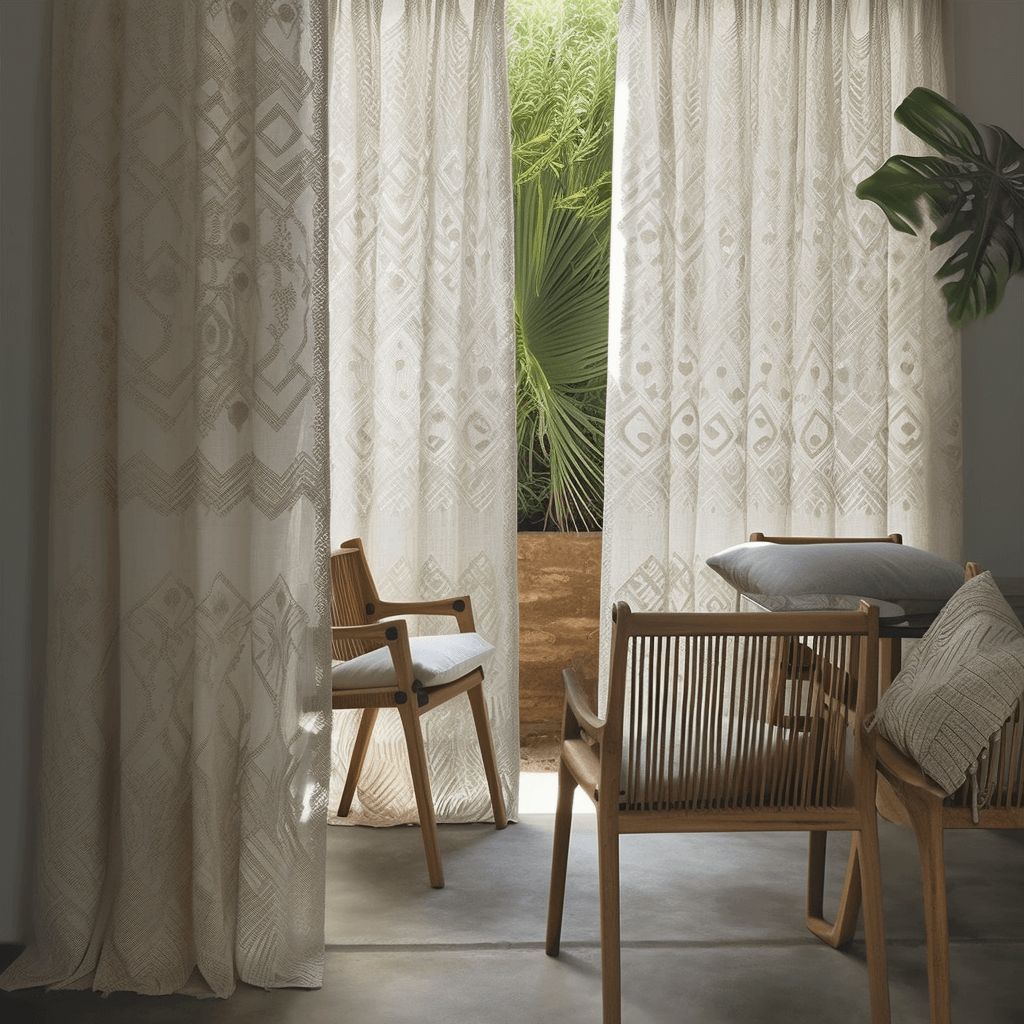

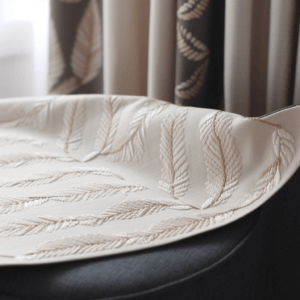

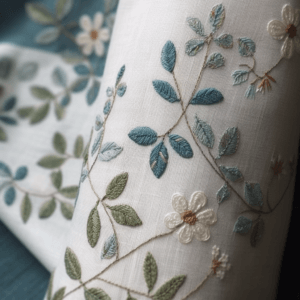

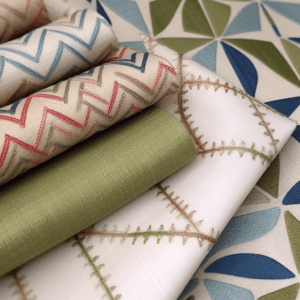

Embroidered Fabrics
Embroidery is the craft of decorating fabric or other materials using a needle to apply thread or yarn. The word embroidery comes from the French word broderie, meaning embellishment. In various forms, embroidery has existed since the production of fabric.
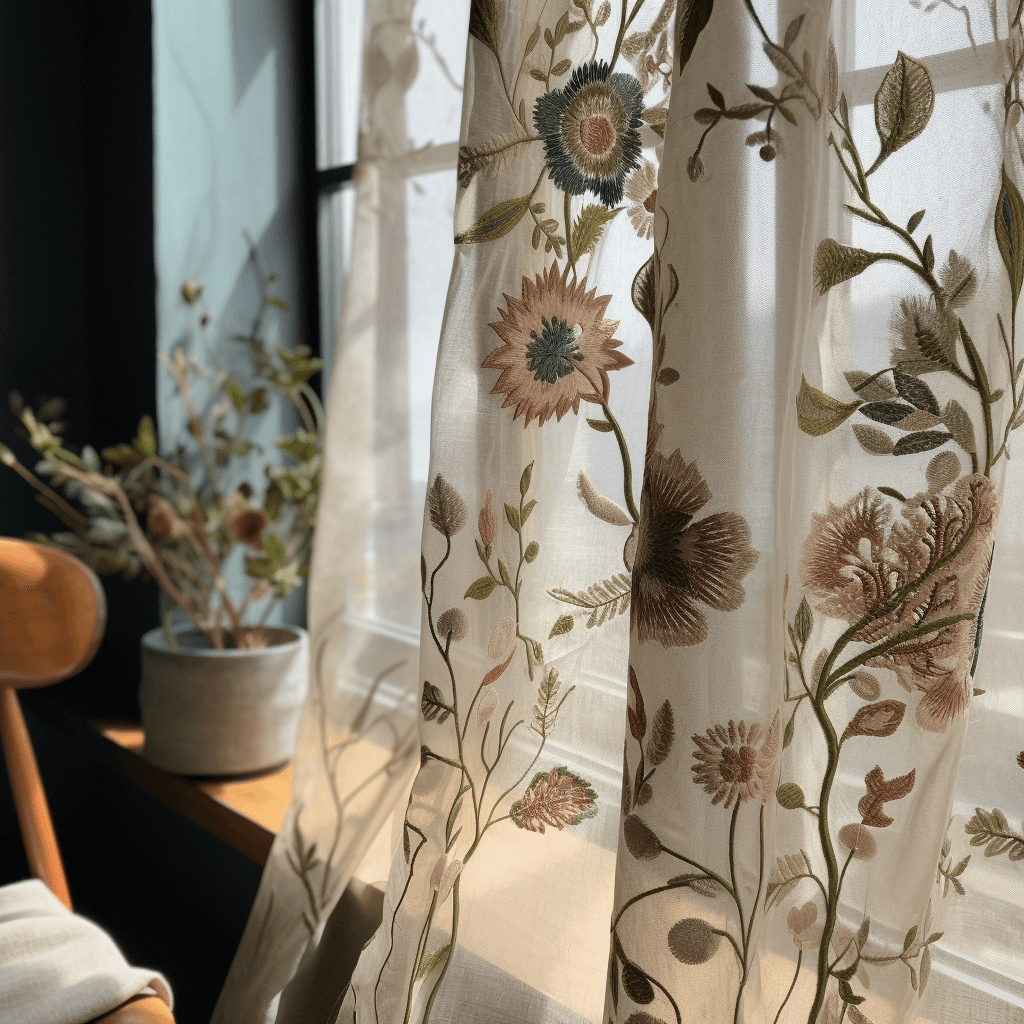

Embroidery Q & A
Is embroidery a good option for upholstery?
Embroidered fabrics are often referred to as strong and suitable for upholstery on some fabric websites. Most embroidered fabrics, however, are not suitable for upholstery. Fabrics with higher durability are needed to withstand the abrasion that most furniture items receive. Use embroidered fabric outside of furniture pieces where abrasion will be less of an issue.
Does puckering occur in embroidery?
Embroidery sizing refers to “gathering” (or “bunching”) of base fabric near embroidery stitchs. This occurs when the fabric is moved around during the embroidering process. More stitches in a design will result in more puckering. A lighter fabric may also pucker more than heavier fabrics. The characteristic of embroidered fabrics is puckering. It is not a defect, but a part of the beauty of textiles.
Why can only some embroidery patterns be purchased in small rolls
Small rolls lengths are caused by the embroidery machine that was used to create the fabric. Some embroidery machines only allow continuous lengths between 20-30 yards while others are able to produce longer rolls.
Why is there a maximum of three widths on some embroideries?
There are many explanations as to why different widths of embroidered fabrics are shown. It is important to know that although the overall width is displayed on the fabric in order to calculate shipping and freight charges, it does not necessarily mean that embroidery will be that size. Modern embroidered fabric is produced on fabrics up to 60″ in width, but the actual embroidered width may be less. In this case, the embroidery might be labeled 60″ wide but only 54″ usable. The embroidery only covers 54″ out of 60″. The embroidery may be stitched to the maximum width of the machine, but this does not guarantee a perfect pattern match. In order to achieve a pattern matching, additional embroidery inches may be required. In such cases, the embroidery will show a total width, a width that can be embroidered, and a width for pattern matching. In some countries, a pattern match is less desired than in the United States. Always check the fabric width listed on the embroidered fabric.
Why are certain elements of an embroidered fabric merged with other elements? This is a defect?
Depending on the embroidery machines used, machine heads need a continuous pattern in order to sew properly. The embroidery heads will not lift or break when a line of stitches is used to join two elements. The joins in the design are hidden to make them as subtle as possible. This is not a defect.
What’s the difference between crewel embroidery and embroidered fabrics?
When comparing embroidery fabrics, the uniqueness of a style is determined by the motifs and stitches that were used. The stitches in authentic crewel embroidery are made with a 2-ply yarn. The crewel is the name of this yarn. In the 16th-17th centuries, crewel embroidery became popular in Jacobean England. Traditional crewel embroidery often displays motifs from the Jacobean era. Jacobean embroidery, which is an entirely different style, is also known as crewelwork.
Embroidery History
Although embroidery is used all over the world, it has its roots in China and the Near East. Early embroidery dates back to the Cro-Magnon era or 30,000 B.C. The fossilized remains of clothing heavily decorated and hand-stitched from this time period were found in archeological discoveries. This was because there were no written records, as this was before written language existed. The earliest art was likely created as part of religious ceremonies.
The oldest pieces of embroidered fabrics date back to approximately 2,000 B.C. These artifacts were discovered in Egyptian tombs. The artifacts found in Egyptian tombs include tunic hem panels of Tutankhamun, the famous Egyptian Pharaoh.
Primitive humans quickly discovered that the stitches they used to join skins of animals could be used for embellishment. In recorded history, vases, sculptures, and paintings depicting ancient civilisations, people are seen wearing clothing with thread embroidery.
In China, there are also early examples of embroidery dating from the Warring States Period between the 5th century B.C. and the 3rd. The earliest embroidery found in Sweden dates back to the Viking Age around the 9th or 10th century. Around the year 1,000, embroidery became more popular in Europe as the Christian church grew and royal power increased. Wall hangings, tablecloths and garments with richly decorated ornaments were ordered to show power and wealth.
In medieval Islamic societies, embroidered textiles represented a high level of social standing. In cities like Damascus and Cairo, embroidery was found on handkerchiefs and flags as well as uniforms and robes.
Sewing techniques were developed from the process of tailoring, patching, mending and reinforcing cloth. The decorative possibilities of stitching led to embroidery. In the 18th century, England, embroidery marked a girl’s transition into womanhood and also conveyed rank and social status.
Around 1855, the Industrial Revolution began to erode the expertise of needlework by hand. The invention of the chain-stitch embroidery machine was a major factor in this. This invention was the start of mass production for embroidered materials. These machines were able to embroider Tambour on netting. Tambour is also known as Broderie chainette or Broderie de luneville and is a beaded embroidery technique.
In 1857, two years later, the chain-stitching sewing machine was patent in the USA. By 1858 it became increasingly difficult to tell the difference between machine-stitched embroidery and hand-stitched. Around 1900, pattern papers and mail-order catalogues helped make embroidery more popular.
As cheaper materials were available, embroidery was no longer a pastime for the wealthy. In addition, embroidery, which was traditionally performed by women, is now enjoyed by men. Henry Fonda, the actor, revealed in an interview that embroidery was his favourite hobby. Gustaf V was a famous male embroiderer. He was the King of Sweden between 1907 and 1950.
In the 1990s, embroidered fabrics became popular worldwide due to the importation from China of faux silk embroidery. The addition of machine embroidery to polyester faux-silk fabrics made for a decorative fabric affordable for many households. Faux silks with machine embroidery remained popular into the 1990s. As the decade came to an end, faux silks became less popular as embroideries began using natural cotton bases. In the following years, rayon and linen fibers were added to the ground fabrics. These fibers, as well as blends, are still popular today.
Many modern embroidery works are stitched on computerized embroidery machines with patterns “digitized” using embroidery software. Different types of “fills”, used in machine embroidery, add texture and style to the final work. The embroidery has evolved in terms of both design and technique. It seems to be retaining its appeal as its popularity grows.
The embroidery of today is very different from that of the past. The majority of contemporary embroidery is done using computerized embroidery machine software and “digitized” patterns. Modern embroidery is different in style and technique from its ancient origins, but the use and purpose of embroidery remains the same. Embroidery is a popular and will always be a way to decorate the interior of homes.